How to Choose the Best Color for Siding Replacement?
One of the first things homeowners think of when it comes time to replace their siding is color. There are definitely other aspects of a siding replacement project that are important, such as the type of siding and finding the right contractor to install it, but for homeowners looking for a specific aesthetic or to blend in with the surrounding homes or to stand out, color is the focal point.
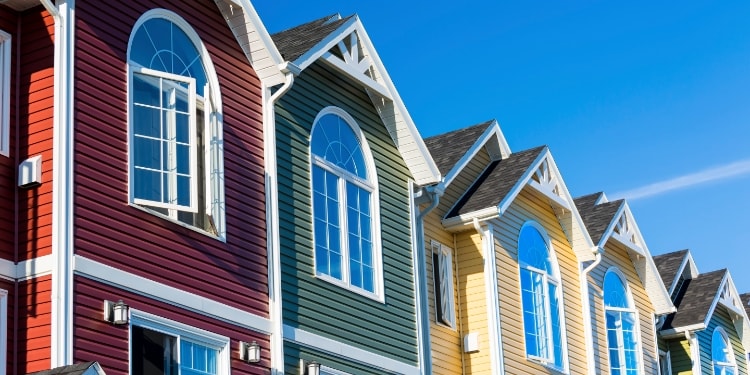
The best color for siding is totally up to the people living in the home, so if you want to know how to choose siding color palettes that will work on your home, read on. At VIS Exterior, we’ve worked with many homeowners in all types of homes and communities and we know how to choose siding colors for your home that also fit your preferences. We also know that colors can impact your curb appeal, which is also going to impact the value of your home.
If the process of choosing a color for your home gives you a degree of anxiety, don’t worry because that’s completely normal. If it wasn’t an important decision it wouldn’t give you so much grief, but just know that VIS Exterior is here to help. None of our clients have ever looked at their completed project and thought they’d chosen the wrong color.
Table of contents:
- HOW TO PICK THE RIGHT SIDING COLOR FOR YOUR HOUSE?

- TOP FACTORS TO CONSIDER BEFORE CHOOSING A SIDING COLOR

- BASIC COLOR RULES TO CONSIDER

- WHAT ARE THE DIFFERENT SIDING COLOR OPTIONS IN THE MARKET?

- CHOOSE THE BEST SIDING COLORS FOR DIFFERENT TYPE OF SIDING MATERIALS

- WHAT ARE THE MOST POPULAR SIDING COLORS IN 2024?

- GREAT SIDING AND TRIM COLOR COMBINATIONS TO BOOST YOUR HOUSE’S APPEAL

- TOP TIPS FOR PICKING THE BEST SIDING COLOR

- MAKE A FINAL DECISION OF CHOOSING SIDING COLOR FOR YOUR HOME

- EXPERT ANSWERS TO YOUR FREQUENTLY ASKED SIDING COLOR QUESTIONS

How to pick the right siding color for your house?
How to pick a siding color for your house begins with looking at what’s available in the type of siding you’re choosing, whether it’s vinyl, made from processed wood fibers or fiber cement. But you also have to consider all the factors in your immediate environment, such as the color of homes around you, the color of your roof and if there are any brick or stone elements to the structure of your home.
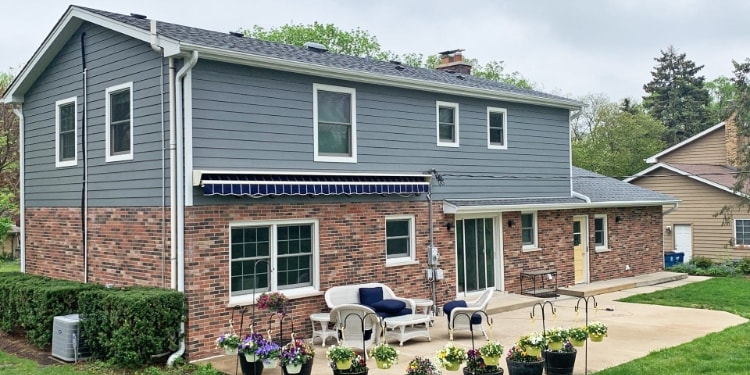
Would choosing a bold color clash with the homes around you? Maybe you want your home to stand apart from others in your area, but what color is too much? For people in this camp, choosing darker colors is usually the go-to option. For those who simply want their home to look nice, but blend in with others, neutral colors are the first choice. What if you live in a smaller home? Choosing a dark color will not make it look larger, but light colors will.
When you’re stumped on how to pick a siding color, think about how long you are going to live in the home, because if you’ll only be there for a short amount of time, think about which colors will add the most curb appeal and make it more sellable in the near future. Do your tastes change frequently? Maybe you’re feeling a bit bold right now and are thinking about a color that will make your home “pop” against others? What if in five years you change your mind? Going with a neutral color is generally the best bet.
Top factors to consider before choosing a siding color
While a siding color looks great on one home, it might look horrible on another. The top factors here are often the architectural style of the home, as well as the lighting it receives. For example, some homes are tucked in between a grove of trees and get little light, while others are in a clearing and get full sun during every daylight hour. Another top factor is your color preference, which can be balanced against these other two factors.
Another important factor is the size of the home. If you choose a dark color for a small home, it might actually make it look smaller. Choosing a light color will make it appear larger. In the sections below, we’ll examine a variety of factors that influence the decision homeowners make about their siding color.
Here are top considerations before choosing a siding color:
Home’s architecture
Do you live in a home inspired by the Tudor design? Many of these have brick or stone incorporated into them, plus darker roofing shingles, which usually means brown, cream and white tones work best for the siding and trim. Each carefully played off the other.
With ranch-style homes, which are quite numerous, you’ll often see these adorned with various tones of blue, gray and lighter brown siding colors.
Victorian homes are also common in the Chicagoland area, and because these homes are so versatile, you’ll see them in a variety of colors, including terra cotta, taupe, light green, light pink and muted turquoise.
The simplicity of colonial architecture fits whites and neutrals best, whereas a Cape Cod-style home seems to prefer blues and grays. Does your home look more like a French cottage? These homes look great in soft colors, including light blue and light gray.
Regardless of whether your home is Georgian style, craftsman, A-frame or something more modern, we can assist you in choosing the right type of siding that will fit the architecture of your home.
Size of your house
Have you been drawn to darker siding colors, but you live in a large home? Be wary of going dark because large homes can look a bit overwhelming, even depressing to some, when they’ve been adorned with dark siding. Go with a neutral shade and avoid making your home look too menacing. Conversely, if you choose a bright color, such as white with a similar tone, a large home can stand out too much. Again, neutral is the best option in almost every situation.
Smaller homes look best when they have a siding color that allows them to blend into other homes, rather than stand out as the smallest one in the neighborhood. Neutral and lighter tones can help these homes blend in.
Roof’s color contrast
Roof color should be a consideration for the color of your siding and trim, as it is a major element on the home that will impact the colors under it. Most roofing material will last up to 30 years, so keep this in mind if your roof is going to be replaced soon, as you’ll want to make sure the siding color will match the new roof if you choose to change the color of the shingles. For example, if you’ve currently got a deeper earth tone, such as a dark brown, the siding that looks best with that is a lighter shade of siding, which will not match well with a lighter shingle color.
Environment and lighting
One of the most impactful environmental aspects to consider is how much light your house gets. For example, in heavily wooded neighborhoods, the amount of natural light that hits the home is reduced substantially from neighborhoods where the landscaping is sparse. Paler, brighter-colored siding is a great option in homes in areas that receive less light. Also keep the seasons in mind, as the darker winter months will contrast with brighter, sunny summers – you’ll want to keep these contrasting environmental elements in mind as you choose a color.
Climate
The late fall and winter months are dreary and can make a home that looks bright and perky during the spring and summer look drab in the darker months. If you live in an area where the climate is extreme, you’ll want to take this into account as you choose a color that will represent well during all seasons. Furthermore, extreme climates can also take a toll on the life of the siding, so you’ll want to be sure to install durable siding from a trusted manufacturer.
The landscape
Landscaping also plays on the color of your siding. For example, if you have a lush, green surrounding during the summer, those various hues of green will impact the color of the siding. If your home is surrounded by Japanese maples, elderberries or crabapple trees, the leaves will be more of a purple hue than green, which will also influence the color of your siding.
Keep in mind that foliage colors, which can vary greatly from one home to another, should be considered as you choose your siding color. Finally, if you have a home with little to no landscaping, be wary of bright siding colors, as this can make the home stand out a bit too much.
Neighborhood colors
You’ll notice most homes in a neighborhood are consistent in terms of the colors of the siding. This isn’t a coincidence, as most homeowners will choose their siding in a color that is similar to the homes around them. Most homes in neighborhoods are also architecturally similar, which is also a consideration when choosing a color.
Should your home differ significantly in its design, that could influence you choosing a color that is not consistent with those around you. It’s always a good idea to maintain a similar color and not try to stand out too much. You can make a statement, but choosing an extremely bold color is generally frowned upon.
Personal taste
Perhaps the most important component of choosing a siding color is personal taste. Everyone has their favorite colors and reasons for why they might choose one over another. From darks to lights, brights to dull, there are so many options available that everyone’s personal preferences can be met, if not by one siding manufacturer, then surely the next. And while blue is the most popular color in the world and perhaps your favorite color, it might not be the best choice for your home. You can still balance your favorite colors against what will be appropriate for your siding color.
There are so many factors that go into choosing a siding color that it might seem intimidating to make a decision. However, by simply taking into account your own personal preferences, your home’s architectural style, what’s consistent with the homes in your neighborhood, your landscaping and the amount of natural light your homes gets, making the decision can be much, much easier.
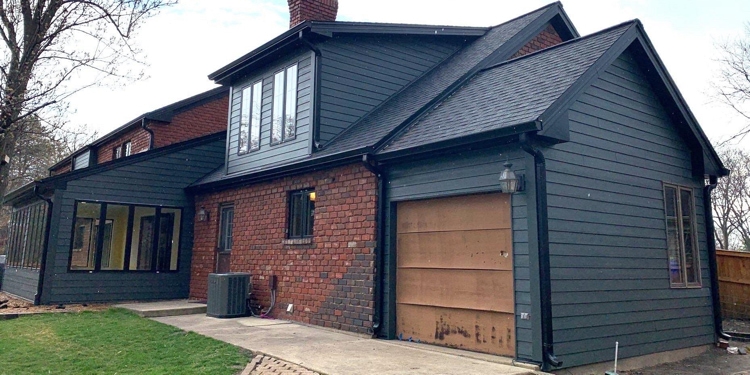
Basic color rules to consider
Looking for some basic rules of colors to help guide you to the right choice? There is actually a science to choosing the right colors, so take these rules into account as you wade through the mountain of options.
Rule of three
The rule of three is based on a design concept where primary and secondary colors are considered in making a more pleasant overall choice.
- Primary — The most prevalent color is your primary color. So, when you order your siding, it will have the most square footage on the exterior of your home and will serve as the primary color.
- Trim — The rule of three will help you choose a secondary color for the smaller portions of the exterior, which will be the trim, fascia and window frames.
- Accent(s) — To round out the rule of three you have the accent colors, which is where you can exercise your personal flare on areas of the exterior where you want a splash of color.
The color wheel
The best way to see all the color options and how each of your colors will work off the others is to use a color wheel. Swatches of colors are represented on the color wheel. If you prefer an earth tone, there will be color wheels with various hues of similar colors so you can pinpoint the hue. For example, let’s say you prefer a primary color of light blue; you can refer to a color wheel with dozens of different blue tones on it.
- Complimentary — Complementary colors on a color wheel are the exact opposite of the other. For example, white siding with black trim.
- Analogous — For hues within the same primary color, you’ll get an analogous color wheel so you can visualize the tiny differences between them.
- Triadic — Want to see three colors evenly spaced on a wheel? Use the triadic wheel, the most basic of which will show you the differences between primary colors, which are red, blue and yellow.
Matching undertones
You want to maintain consistency in your colors, so you need to match your undertones with your primary color choice. For example, blue is a “cool” color, which means your undertone should also fall into the “cool” variation. If you’ve chosen a “warm” color, such as yellow or red, you’ll want to make sure your undertones match that warmth.
What are the different siding color options in the market
From autumn red to coastal blue, cypress to light maple, think of a color and it’s probably going to be an option in your choice of siding. And while most people say they have a favorite color, choosing a color for siding isn’t that simple. You want to make the right choice because it’s going to be in your home for decades to come.
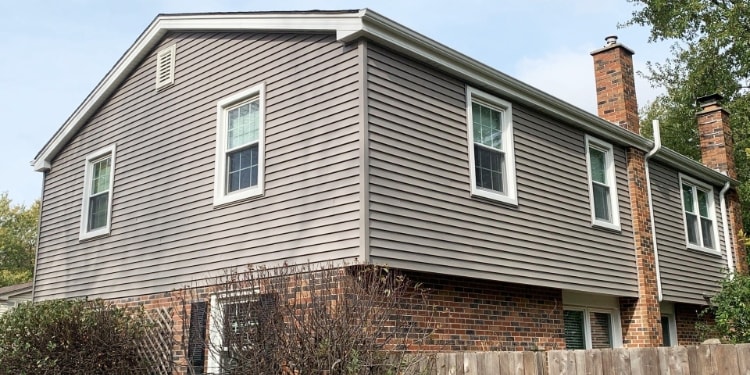
One thing is certain: if you use the right color of siding on your home, it can boost its curb appeal and perhaps even the value of the home. Make the wrong decision and the reverse is true. The rule of thumb is to stay within what is trending today and what is modern. While this might not be the best color two decades from now, you can rest assured that for the time being and well into the next decade, your color will be appropriate.
Making the siding color choice is important, but so too is the secondary colors, which will be your trim, fascia and window frames. Work with your siding contractor and you will get a better sense of what your options are.
Here is a list of available siding colors that you should know before you make your decision:
White siding and neutral color tones
White siding and neutral siding colors are extremely popular and have stood the test of time for centuries. A white siding house is easy to accent, as is a home with neutral siding colors. However, white can make a home appear bigger, which is a benefit on smaller homes but can be a distraction for larger ones.
If you’re looking for flexibility with your color scheme, you will probably want to stick with the neutral tones, as these are also easy to pair with various accents on a home, from stone or brick to boldly colored doors.
Gray siding colors
Gray siding colors are also a longtime favorite of homeowners. From dark gray siding to light gray siding, there are many options out there that work with just about any roof color. You can even go with gray siding with white trim, as this can make a home pop without going too far but also provide some of that vintage charm. Gray also works with warm or cool undertones, which means you have many options.
Brown siding colors
For those looking for a more contemporary look, the brown siding colors are a great option. Dark brown siding with white trim or a variation of white can provide a modern look without making your facade look too dark. It just adds that contrast that is pleasing to the eye.
Light brown siding with dark brown trim is another classic look that offers a “tone-on-tone” aesthetic that highlights the windows, doors and roofline. There are actually many, many shades of brown that will fit just about any preference in that tone.
Green siding colors
If green is appropriate for your style of home and your neighborhood, you definitely have options. While it’s considered a bit of an oddity for siding, there are some green siding colors that will look great on your home, particularly if you’re going for a Mother Nature theme.
If your home has a partial stone facade, green siding is a great match because it blends seamlessly with stone. Also, a green siding house will look great with a variety of secondary colors, as it’s an easy color to mix with others. Finally, if you’re afraid green will be too out of the ordinary for your neighborhood, go with a dark shade of green, as it will be less eye-catching than a bright green.
Blue siding colors
Blue siding colors are forever popular. You’ll see a light blue siding house next to a dark blue siding house in neighborhood after neighborhood because the color is so popular. Blue is known for its psychologically calming effect, but it’s popular in homes because it complements just about every architectural style while also fitting well with a variety of secondary colors.
For those reaching for a more unique look, choose white trim. If you’re torn between blue and green as your primary color, there are blue tones that have a green base to them.
Black siding color
Black is definitely on the “bold” side of the siding. Black siding house colors make a big exterior statement, particularly for modern homes or for homeowners seeking to make their homes appear more modern. Dark exterior siding will help large homes look smaller, but can make smaller homes even more diminutive.
If going black with your primary color is a tone too bold for you, you can achieve some of the same aesthetic with black trim. While black siding isn’t common, when done right it can be quite beautiful on a home of just about any architectural style.
We’ve only scratched the surface of colors you can choose for your siding. If you have questions about other colors that will look great on your home, contact us at VIS Exterior and we will help you make the right decision.
Choose the best siding colors for different type of siding materials
Look for the best siding colors that will make your home look great? There are so many types of siding, as well as different types of siding colors, so there is plenty to choose from. It’s safe to say making the decision will be one of the more important ones in regard to your home, but with some guidance, you can get started down the right path.
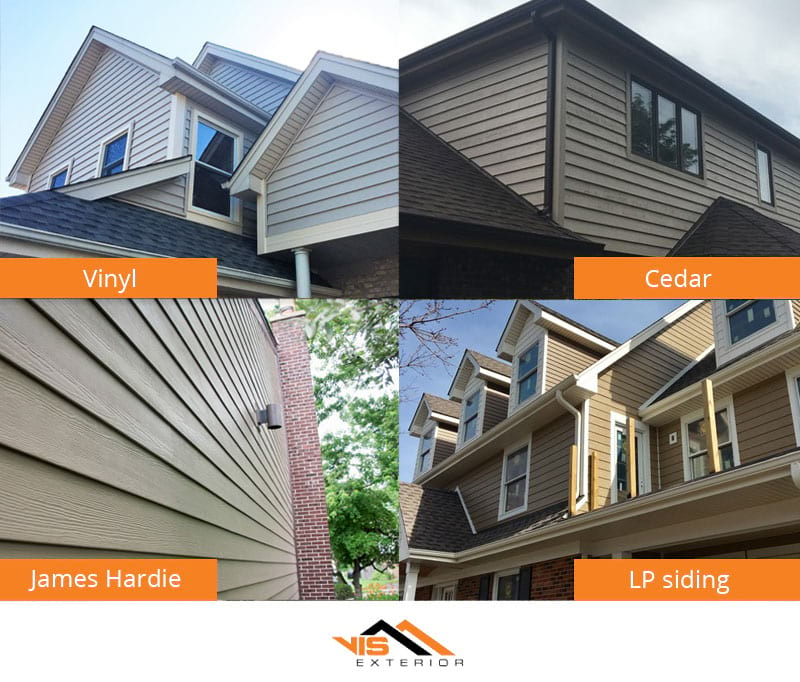
From insulated vinyl to vinyl, fiber cement to wood, real wood shake or even stone siding, you’ve got choices there, too. But focusing on the color palette is what we’re here to talk about and we’ll make sure that regardless of the material you use, you’ll get the right color.
When it’s time to replace your siding, you want the finished product to provide you with more curb appeal and value, so if you want to get the most out of your exterior appeal, consider the following advice.
Best colors for vinyl siding
Vinyl siding is the most popular material on the market because it is affordable and easy to install, but also provides little to no maintenance over its lifetime. The other reason it is so popular is the abundance of vinyl siding colors. To know how to choose the right color of vinyl siding, you need to consider a few elements, not the least of which is your style of home, the popular colors in your area and the amount of light your home gets.

The best colors for vinyl siding are those that maintain the value of your home, especially if you’re planning on selling it soon. And if you’re planning on living in the home for the next two decades, you want vinyl siding colors that will keep you happy for those 20 years, which means you’ll want to choose something that is modern and trending now and will likely remain popular for the duration of your stay.
As you’ve probably guessed, there are hundreds of vinyl siding colors from which to choose, so come to the selection process with an open mind and the facts you need to make the right decision.
CertainTeed vinyl siding colors
Vinyl siding comes in a variety of shapes and sizes, including CertainTeed siding, which is available in shakes, vertical or horizontal sizes, all of which are made to look like real wood. The wood look is a style that has captured the eye of homeowners for centuries, so it’s no wonder that CertainTeed siding is so popular.
CertainTeed vinyl siding colors come in a range from bold to subtle, bright to dark. Textures and thicknesses also vary depending on what you want for your home. If you’re looking for insulated vinyl siding, they’ve got you covered, but it also comes in non-insulated varieties. Are you a fan of warm hues? CertainTeed offers many, many warm colors, but also offers as many colors in the “cool” temperature.
With more than 40 color choices, CertainTeed siding brings plenty to the table when it comes to fitting a specific aesthetic. But to assist homeowners in singling out a color, CertainTeed offers a few different lines where colors are grouped based on their tones.
Here are CertainTeed colors options for your home’s siding:
Mainstreet vinyl siding colors
Autumn Red, Autumn Yellow, Buckskin, Castle Stone, Charcoal Gray, Colonial White, Cypress, Desert Tan, Flagstone, Forest, Granite Gray, Hearthstone, Herringbone, Light Maple, Natural Clay, Oxford Blue, Pacific Blue, Sable Brown, Sandstone Beige, Savannah Wicker, Seagrass, Snow, Spruce, Sterling Gray.
Restoration Classic vinyl siding colors
Autumn Red, Autumn Yellow, Buckskin, Castle Stone, Charcoal Gray, Colonial White, Cypress, Desert Tan, Expresso, Flagstone, Forest, Granite Gray, Hearthstone, Heritage Cream, Herringbone, Light Maple, Melrose, Midnight Blue, Mountain Cedar, Natural Clay, Olive Grove, Oxford Blue, Pacific Blue, Sable Brown, Savannah Wicker, Smoky Gray, Sterling Gray.
Monogram vinyl siding colors
Seagrass, Arbor Blend, Autumn Red, Brownstone, Buckskin, Castle Stone, Cedar Blend, Charcoal Gray, Colonial White, Cypress, Desert Tan, Driftwood Blend, Espresso, Flagstone, Forest, Frontier Blend, Granite Gray, Herringbone, Heritage Cream, Hearthstone, Light Maple, Melrose, Midnight Blue, Natural Blend, Natural Clay, Olive Grove, Oxford Blue, Pacific Blue, Rustic Blend, Sable Brown, Sandstone Beige, Savannah Wicker, Seagrass, Slate, Smoky Gray, Spruce, Sterling Gray, Tuxedo, Weathered Blend, Weathered Wood, Wedgewood Blue.
What are the most popular CertainTeed vinyl siding colors?
Some of the more popular vinyl siding colors on CertainTeed products include various tones of blue, of course, as it is a popular color on any brand of siding. In 2024, the most popular siding color was white, as it is considered a timeless classic. White began to draw an increasing amount of popularity throughout 2021, too. The best vinyl siding colors for you might not always be the most popular. For example, your house is large for your neighborhood, which means you probably wouldn’t want to choose white, as this color only makes it appear larger.
Check out the following most popular colors for CertainTeed siding and see if they work with your tastes.
CertainTeed Sandstone Beige siding
CertainTeed Sandstone Beige is a departure from the classic white siding, but offers a robust amount of secondary colors for your trim and other areas of the exterior.
If your home has shudders, consider going with a red tone on those with your sandstone beige vinyl siding.
CertainTeed Charcoal Gray siding
CertainTeed charcoal gray siding offers those deep and dark undertones that can give a home a more modern look. Furthermore, this hue is befitting of just about any type of architectural style.
Looking to create an ultra-modern look? Try white trim with this color of siding.
CertainTeed Sterling Gray siding
CertainTeed sterling gray siding is considered a “true” gray color, but is definitely on the lighter side compared to the charcoal gray variety.
Consider a blue, green or black pairing with sterling gray vinyl siding, or even branch out with some accent colors of your choosing if you’re looking to make your home “pop.”
CertainTeed Pacific Blue siding
CertainTeed Pacific blue siding is quite popular right now, as it matches many homes in neighborhoods through the area, but it also pairs well with so many other colors, which means you can stay consistent with your neighborhood, but define your own style with various color accents.
CertainTeed blue siding will likely remain popular for years to come.
CertainTeed Sable Brown siding
If you think brown is too drab, consider CertainTeed sable brown siding, as this color works really, really well with bright trim colors that make a home really stand out.
Yes, sable brown is an earth tone that has an understated vibe, but it also plays well with so many other colors that provide a perfect balance.
CertainTeed Seagrass siding
For homeowners seeking a lighter, more vibrant color, consider CertainTeed seagrass siding, as it offers a greenish blue hue that looks really clean, yet lively.
CertainTeed seagrass vinyl siding might not work in every neighborhood, but it has made an impact in those where it works.
While these are popular offerings from CertainTeed right now, don’t limit yourself to just this handful of examples. Explore the many options you have and choose what’s best for your tastes and your home.
Best colors for fiber cement siding
Fiber cement siding is gaining in popularity because it is so durable and looks fantastic, but it’s also a bonus material because it will accept just about any color you can think of. So, you can get that real wood look, but also have it in a wide assortment of colors.
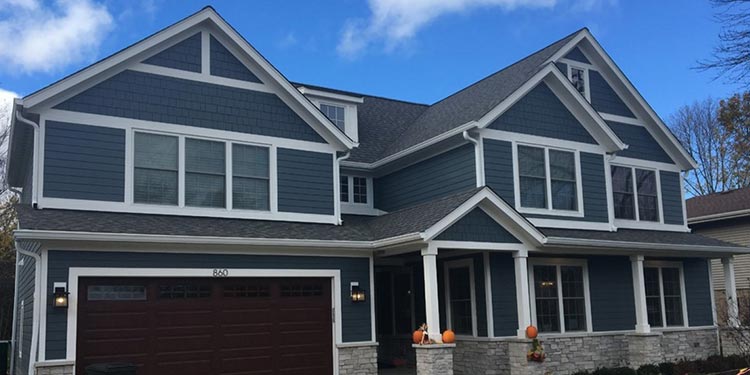
The other thing about fiber cement siding colors is that you have them on a variety of different types of siding, from panels to boards to lap. There are a variety of sizes from which to choose, which is also attractive and opens up design opportunities. It’s important to choose the right contractor to install your fiber cement siding, as it is different from other products and requires some knowledge and previous experience to install it correctly.
Furthermore, choosing the right contractor also entails getting advice about fiber cement siding colors, as they will have experience with a variety of siding types and colors that have worked on similar properties in the past.
James Hardie fiber cement siding colors
The leader in fiber cement siding is James Hardie, a company that is a recognized leader in this type of siding, which has been installed on more than 10 million homes in North America. Installing James Hardie siding improves your curb appeal and increases its value. For those who are eco-minded, you’ll enjoy the fact that James Hardie embraces sustainable manufacturing processes.
James Hardie fiber cement siding colors run the gamut of options, from khaki brown to mountain sage, evening blue to gray slate. You can get your siding in the color palette of your choice, as James Hardie pre-paints all its products and offers a warranty on the siding. Homeowners looking for fiber cement siding color options need not be afraid that choosing this type of material will impact their options in a negative way because there are plenty.
Here are some of their attractive Statement Collection™ options for your home’s siding color:
Warm colors:
Khaki BrownCool colors:
Gray Slate, Boothbay Blue, Evening BlueFresh colors:
Mountain SageLight colors:
Arctic WhiteDark colors:
Aged Pewter, Evening BlueNeutral colors:
Arctic White, Cobble Stone, Monterey Taupe, Khaki Brown, Pearl Gray, Gray Slate, Aged Pewter
What are the most popular James Hardie siding colors?
James Hardie siding colors are indeed numerous, but there are some favorites year to year. The most popular James Hardie siding colors in 2024 are Aged Pewter, Arctic White, Boothbay Blue, Cobble Stone, Countrylane Red and Evening Blue.
James Hardie is known for having a beautiful plethora of gorgeous siding colors. They have just about any color for your home, from classic neutrals to warm undertones. Their Statement Collection™ features their most popular ColorPlus® Technology colors. Users can use the Statement Collection™ tool to search ColorPlus® colors available near their specific region via zip code.
Dark gray James Hardie Aged Pewter siding
James Hardie Aged Pewter siding is best described as dark gray with sandy hues. James Hardie says that “pewter also sometimes has a hint of purple and works excellent with both cool and warm tones.
If you use Aged Pewter for your siding, go with a white, beige, or light brown for your accent color.” For anyone who is a fan of the gray tones, James Hardie gray siding will be a hit with them.
James Hardie Arctic White siding
James Hardie Arctic White hits on all the characteristics of the classic white look, but this one is a bit muted yet still able to brighten up a home’s exterior.
Looking for a nice accent or subtone to go with this James Hardie Arctic White siding? Try a brown tone or taupe.
Neutral tone James Hardie Cobble Stone siding
James Hardie Cobble Stone is a big hit with homeowners looking for that natural aesthetic. It’s also the preference for those looking for a rustic look, which is often achieved with natural stone (thus the name).
This James Hardie Cobble Stone color is best described as a light taupe. It matches well with brown or green trim colors.
James Hardie Light Mist siding
James Hardie Light Mist is a gray color that falls squarely into the neutral area, meaning it will not clash with any color. This is a perfect color for anyone who wants to personalize the accents of their exterior with anything from white trim to dark green shutters.
Neutral James Hardie Monterey Taupe siding
James Hardie Monterey Taupe is also a popular neutral color that offers a modern look that matches with many, many other colors. This means you can keep the majority of the square footage of your exteriors neutral, while choosing accent colors that are bold.
Brown James Hardie Timber Bark siding
Want a brown look for your home’s exteriors? Choose the James Hardie Timber Bark siding. It’s a warm and earthy feel that really takes that brown hue to the next level. And because James Hardie Timber Bark is a darker color, you’ll want to choose brighter accents, such as Arctic White, Cobble Stone or Monterey Taupe.
Don’t feel that you have to limit yourself to what’s popular in 2024. Mix and match colors of your choosing and James Hardie will be able to produce them for you. As always, VIS Exterior is the go-to James Hardie siding contractor and knows exactly how to install it on your home.
Best colors for wood siding
The best color for wood siding depends on a variety of factors, the first being your personal taste. Next, consider the architecture of your home and its size. Do some colors work better than others? But as you consider wood siding colors, take a look around your neighborhood and see what others have done with their siding. It’s usually best to stay consistent with what other homeowners have chosen for their siding.
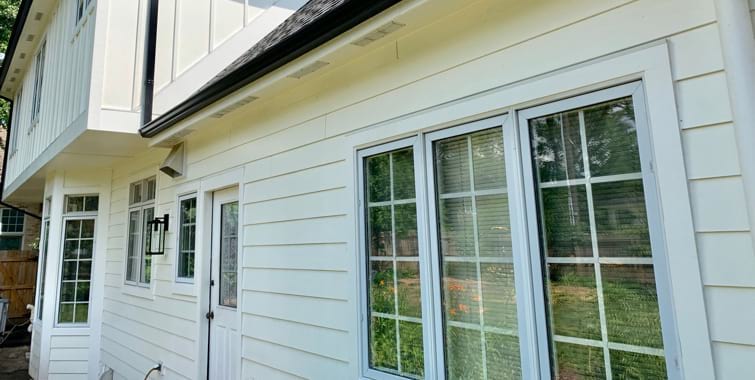
At VIS Exterior, we know that choosing siding colors can be a daunting task, but we’ve helped many clients with wood siding and making all the important decisions that are involved. Fortunately, we work with LP SmartSide, which is a company that has a history of innovation and develops its siding with a huge palette of colors to choose from.
LP SmartSide continuously works on creating stronger and longer-lasting products while also focusing on protecting the environment. As color preferences change, LP is going with the flow and offering all the unique, popular and rare colors that the market demands.
LP SmartSide siding colors
LP SmartSide siding colors are vast, which is a bonus to homeowners interested in this type of siding. Choose from timeless colors to LP siding colors that are newly popular with homeowners or anything in between. Looking for a stain-like finish? They can also provide you with that if you are going for the natural wood look in any number of hues, from walnut to mid-tone browns to lighter white-washed wood.
Choose a primary siding color, then choose another color for your trim, soffit and fascia. Need help making those secondary choices? LP can help you with that, as can your trusted siding contractor. At VIS Exterior, we really love working with LP because their products are custom finished to order. For example, there is the ExpertFinish line of colors, which number 16 in all, that are prefinished and guaranteed to look awesome on your home.
Here are LP SmartSide colors options for your home’s siding:
Snowscape White
Shoreline Cream
Quarry Gray
Prairie Clay
Marshland Moss
Terra Brown
Timberland Suede
Canyon Brown
Sand Dunes
Desert Stone
Redwood Red
Tundra Gray
Summit Blue
Cavern Steel
Rapids Blue
Abyss Black
What are the most popular LP SmartSide siding colors?
The most popular LP siding colors will vary from year to year, but lately the focus has been on white, warm neutral tones, gray, brown and blue. At VIS Exterior, we know that LP SmartSide is a leading siding provider for a reason – it lasts a long time and looks great on homes. Part of the reason it looks so good is because of the variety of colors they offer customers. There are seemingly countless color combinations that go great with a variety of LP material types and shapes.
LP SmartSide Snowscape White siding
LP SmartSide Snowscape White is a welcoming bright color that is a classic, but can also work well on homes where the modern aesthetic is desired, which can be achieved by choosing the right secondary colors for the trim, soffit and fascia.
Want a bold contrast? Go for a darker trim color.
Neutral LP SmartSide Sand Dunes siding
LP SmartSide Sand Dune siding achieves the warmer neutral tone that is popular today. It looks great on a variety of home styles and mixes well with either white or dark colors, particularly a dark brown on the trim and other accents.
LP SmartSide Terra Brown siding
LP SmartSide Terra Brown siding is a big hit because earth tones are so in vogue right now. For homeowners going for the earthy aesthetic, we recommend going with the Terra Brown on the siding as well as the trim.
Looking for other shades of brown? LP has a wide selection of browns from which to choose, both light and dark.
LP SmartSide Quarry Gray siding
Some houses look amazing with a lighter, more neutral siding color. LP SmartSide Quarry Gray siding is a perfect match for that. The neutrality of the color offers an exciting array of choices for secondary colors on trim, soffit and fascia.
LP SmartSide Summit Blue siding
Want to stand out in your neighborhood but not go too far? Choose LP SmartSide Summit Blue siding. Blue is an excellent choice for contrasting the earth tones and neutrals that so many of your neighbors have chosen, yet it is still a subtle color with its gray undertones.
These are the most popular LP SmartSide options today, but if you have other colors in mind, the company will certainly deliver on matching your personal style. At VIS Exterior, we’re big fans of LP and will continue to be.
At VIS Exterior, we know making a decision on siding is a process that takes time and some direction, which is why we’re here to help. When you work with us, you’ll never have to worry about regretting your choice, as we’ll make sure it’s an informed choice.
What are the most popular siding colors in 2024?
The most popular siding colors in 2024 run in a variety of tones of some long-time favorite colors. These include white, gray, brown, yellow, green and blue. There are some tricks to choosing the right color for your home, as what works on your neighbor’s house might not work for yours. Architecture, home size, natural light and what’s prevalent in your neighborhood are generally the things to consider when making a decision on color. The following are some of the hot colors for 2024, which will probably be popular for years to come.
Here are our top siding colors for 2024:
Wonderful white siding house
White house siding: Did it ever really go out of style? While blues and grays might have put white lower on the list of preferences for years, it’s always been the choice for anyone wanting that classic look. White fiber cement siding is now trending, as the material has gotten popular and the white color is once again toward the top of the list of preferred colors.
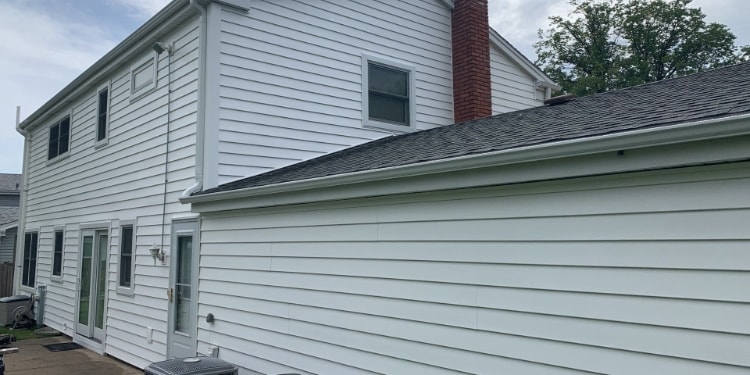
White offers a clean, yet modern look that some feel provides a sophistication that other colors cannot provide. For homeowners with smaller homes, using white can make it look larger. Furthermore, white matches any roof color, so your roof will not be a limiting factor. Also, you choose just about any accent color and it will work with white wood siding.
Top white siding color options for 2024:
- CertainTeed Colonial White color for vinyl siding
- James Hardie Arctic White color for fiber cement siding
- LP SmartSide Snowscape White color for wood siding
Classic gray siding house
From light gray siding to dark gray siding, gray wood siding to gray fiber cement siding, it seems that no shade of gray or type of material will let you down when it is installed on your home. Take a look around your neighborhood and you’ll probably notice a plethora of grays on exteriors everywhere.
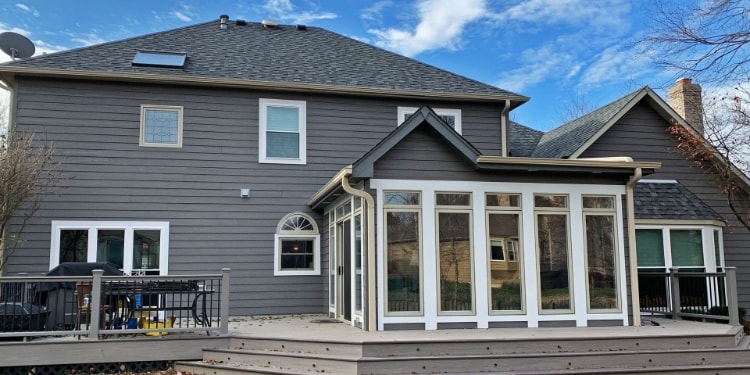
What’s fun about gray siding is that you have a choice between numerous secondary colors that will work perfectly with gray. If you’re feeling bold, you can choose a color for your trim that really pops. And while darker gray siding has been all the rage in 2024, there are still plenty of homeowners going with a lighter shade and finding success.
Top gray siding color options for 2024:
- CertainTeed Charcoal Gray color for vinyl siding
- CertainTeed Sterling Gray color for vinyl siding
- James Hardie Aged Pewter color for fiber cement siding
- James Hardie Light Mist color for fiber cement siding
- James Hardie Gray Slate color for fiber cement siding
- LP SmartSide Quarry Gray color for wood siding
- LP SmartSide Tundra Gray color for wood siding
Neutral color siding house
Throughout the country, homeowners are choosing neutral colors for their siding. In many ways, a neutral color is an easy choice, simply because it first just about every style of home and is easy to match secondary colors to. Furthermore, neutral colors blend with your surroundings, regardless of what type of landscaping is around you.
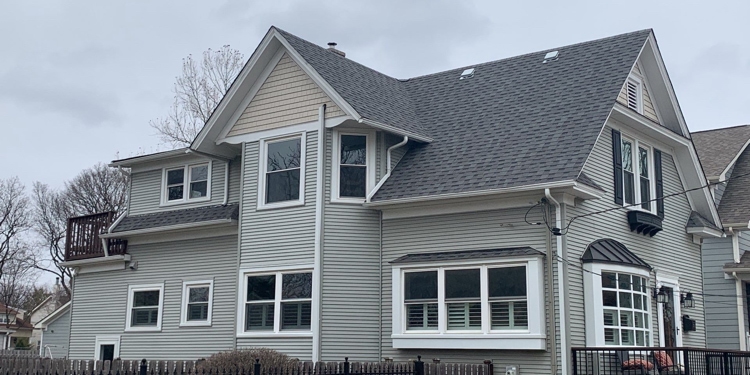
If you’re focused on staying consistent with other colors in your neighborhood and absolutely do not want to clash, neutrals are definitely the way to go. That doesn’t mean you can’t get creative with your shudders, trim or soffits and fascia. Choose a fun shade of green for your shutters if you want to express a little individualism.
Top soft neutral siding colors for 2024:
- CertainTeed Desert Tan color for vinyl siding
- CertainTeed Sterling Gray color for vinyl siding
- James Hardie Navajo Beige color for fiber cement siding
- James Hardie Pearl Gray color for fiber cement siding
- LP SmartSide Sand Dunes color for wood siding
Earth tone brown siding house
Earth-tone siding finds itself on the opposite spectrum from white siding, which is exactly what some homeowners are looking for. They want that cozy aesthetic instead of the stark whiteness. Earth tones bring Mother Nature to mind, from greens to blues, browns to tans and even some unstated red colors.
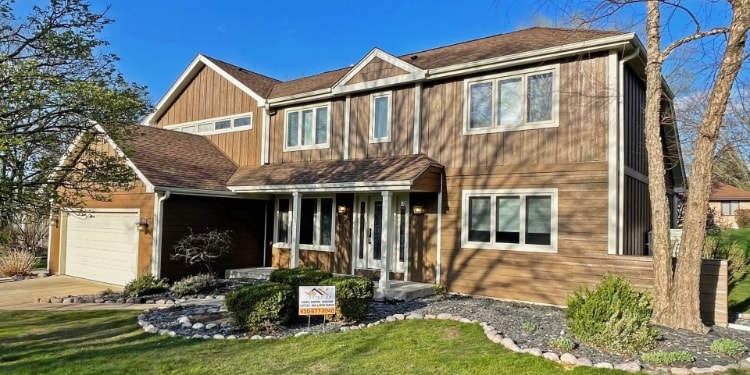
If you want your home to truly blend in with your surroundings, you’ll choose brown vinyl siding or brown wood siding. When homeowners put a lot of time and energy into the landscaping and want it to shine, they choose earth-tone siding so the house doesn’t take away from the lush landscape around it.
Top brown siding color options for 2024:
- CertainTeed Sable Brown color for vinyl siding
- CertainTeed Savannah Wicker color for vinyl siding
- CertainTeed Natural Clay color for vinyl siding
- James Hardie Timber Bark color for fiber cement siding
- James Hardie Navajo Beige color for fiber cement siding
- LP SmartSide Terra Brown color for wood siding
- LP SmartSide Canyon Brown color for wood siding
Blue siding house
From light blue siding to dark blue siding, this color is extremely popular today. You can choose blue vinyl siding, blue wood siding or blue fiber cement siding and you will be among many others who have made similar choices and all agree that it was the right move for their home.
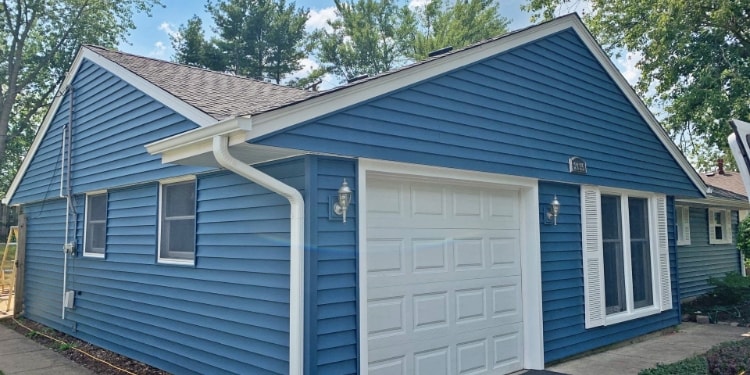
Why is blue so popular? The answer seems to be related to its psychologically calming effect. That being said, blue is also going to work with just about any color of roof and secondary colors on the trim and other areas of the home are easy to match with blue. Finally, with so many homes in your neighborhood with various shades of blue siding, yours will not clash with the others in your area.
Top blue siding color options for 2024:
- CertainTeed Pacific Blue color for vinyl siding
- James Hardie Boothbay Blue color for fiber cement siding
- LP SmartSide Summit Blue color for wood siding
With a little information about the latest trends, are you ready to pick a color or have you at least narrowed it down to a select few? At VIS Exterior, we can give you a hand making that final selection and we’ll install your siding with professional results.
Great siding and trim color combinations to boost your house’s appeal
You can truly boost your house’s appeal by choosing the right house siding and trim color combinations. In order to make sure you’re choosing the right color combinations, you can follow what some designers do. For example, designers often refer to the dominant or largest areas of the exterior as the “field color,” which can also be called the siding color. Next, you have your doors and shutters and other structural elements that are smaller than the siding, which is called the “accent color.” Finally, you have the “trim color,” which is as obvious as it sounds - the trim pieces that are often long and line the straight edges of the exterior or window frames.
Most designers recommend a strong contrast between the field (siding) and The trim color. But some homeowners do not want that much contrast and will opt for more neutral colors. It’s really up to you and your tastes, but the following information can help you avoid clashing colors.
Here we provide different attractive siding and trim color combinations:
White siding house with white trim
There is no better way to achieve the classic, even vintage look, than to choose white siding with white trim. Yes, it breaks the contrast rule that many designers follow, but they know that the white-on-white scenario really works on some homes.
White siding house with black trim
To get the most possible contrast possible between siding and trim, take the white siding with the black trim approach. This works well on any style of home, but there might be some limitations with large homes, as white will make it appear even larger.
Gray siding house with white trim
Looking for a visually bold statement? Try gray siding with white trim. The white will really define the edges and make the home pop. Also, consider dark gray siding with white trim for an even bolder take on this color combination. If dark gray on its own is too gloomy, the white trim will definitely pep things up.
Gray siding house with cream trim
White is too bright for some people and some neighborhoods, but cream trim, which offers a warmer tone, will be a great match on a gray siding house. It’s often been said that this color combination is perfect for Victorian-style homes.
Gray siding house with gray trim
A gray siding house with gray trim might seem redundant, but it really works for some homes. Even a subtle variation in the tones between the gray siding and gray trim can offer the slightest twinge of contrast. Many homeowners find that when they match the siding with the trim, they achieve a seamless look.
Gray siding house with black trim
There’s no denying the popularity and continuing trend of gray siding, but if you want a bold look, consider black trim on your gray siding home. Gray siding with black trim is often described as a neutral-on-neutral pairing that offers a great amount of contrast.
Also, did you know that when people see black trim and other accents in black on a home, they perceive the home as more expensive?
Brown siding house with white trim
You like the color brown and are considering it on your home, but is it too dark? You want that earthy tone but would like to bring some lightness to the exterior, and that’s where brown siding with white trim comes in.
You get to keep your warm and earthy dominant color, but the white adds a ton of contrast that can even make your house appear taller.
Brown siding house with cream trim
A brown siding house often begs for contrasting accent colors, and cream trim does that job spectacularly. For example, let’s say you’ve chosen a rusty brown, perhaps even an orange/brown siding color – your cream trim enhances that warmth while adding contrast.
Blue siding house with white trim
An absolute American classic is the pairing of dark blue siding with white trim. It doesn’t matter if your siding is a light blue or dark blue, add that white trim and you’ve attained that classic look that so many homeowners strive for.
If a blue siding house with white trim is too bright, you can also consider just about any shade of blue with darker trim, including black and gray.
Blue siding house with brown trim
If you feel your home lacks dimension, consider blue siding with brown trim. Blue siding fits in just about every neighborhood and is a highly popular color, but the brown adds some vibrancy and sophistication that will make your exteriors pop, but maintain its uniformity.
Neutral color siding house with dark trim
Does dark trim pair well with neutral siding colors? The answer is yes! While you’ll see more trim in white or lighter color, dark has its place. “Alluring” is the word that best describes what’s achieved with this mix, whether it’s a light gray with a dark gray trim, dark green with black trim or anything in between.
Is your siding of choice a light neutral color? You can create extra contrast by using the dark trim of your choosing. You can also choose a dark trim with darker neutral siding colors that creates less of a bold statement.
The great thing about classic colors is that they remain classic year after year because they continue to add depth to exteriors. What’s fun about these neutral classics is they pair so well with so many different trim colors. From cozy to sophisticated, neutral colors matched with the right trim colors can achieve a variety of looks.
Top tips for picking the best siding color
Looking for how to pick siding color for your house? We’ve got some top tips for you to consider moving forward with your project. Picking siding color can seem like a daunting task, but when you follow a few guidelines, it is a much less intimidating process.
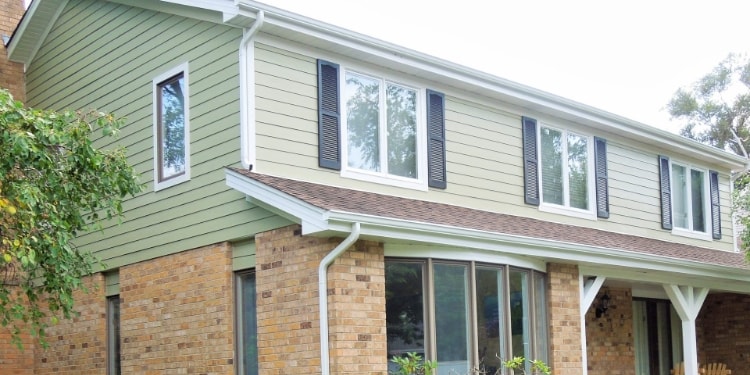
Select the right siding material
Fortunately, there are far fewer siding materials from which to choose than there are colors. And while picking siding color is important, so too is selecting the right materials. Once you have made a decision on the material type, how to pick siding color for your house should be easier.
Combine siding and trim colors
If you’re looking to sell your home, take into account what’s hot on the market and stay with those color trends. But even if you plan to stay in your home for another decade or more, you’ll still want to pay attention to siding and trim colors that combine to create a wonderful exterior aesthetic. There are definitely color trends that can help you make that decision moving forward.
Consider the other surfaces and fixtures of your home
Making the decision on your siding and trim colors factors in a variety of things, such as the color of your roof and other elements on and around your home. For example, do your windows, shutters, outdoor lighting fixtures and doors follow a specific color pattern? You can use these elements to make a more informed decision on siding and trim colors. Of course, if it’s time for a major change, you can also have these elements painted or replaced to match your new vision.
Evaluate your personal preferences
The foundation for most decisions on color is a personal preference. Some homeowners are more comfortable with the cozy look that earth tones bring, while others lean more toward bright and light colors. Some trim colors look better with earth tones than they do with brighter tones and vice versa. Or maybe you fall into the “serene” category, which means you’ll want to seek out soft blues, pale greens and light grays for your siding.
Stroll through your neighborhood and take note of the colors represented on homes and see how your vision for your home matches the overall feel of the neighborhood.
Think about resale value
It’s difficult, if not impossible, to guess what colors are going to be in vogue two decades from now, which is how long your siding is going to last – probably longer. So, when the day comes when you want to put your house on the market, you want the color to be one that will boost your resale value. This means that if your siding color preference is big and bold, which is not the norm, you’ll probably not get as many offers. Unless your unique tastes are that important to you, stick with something that is more “classic” and likely to stand the test of time.
Find color schemes you like on other houses on your street
Look at the homes in your neighborhood and find ones that stand out to you. What is it about the colors that you like? Do the siding and trim contrast greatly, or is the contrast subtler? Are there homes that fit the architectural style as yours look similar in terms of the siding and trim colors?
Sticking to architectural guidelines where color is concerned can make the job of finding the right colors far easier.
Test color swatches before committing
While finding homes like yours with colors you think look great is a perfect way to choose your siding and trim, that’s not always going to be available to you. Therefore, take color swatches and hold them up to your home to get a visual. Test the swatches out on all sides of your home to ensure it’s going to look consistent throughout.
Consider siding maintenance and durability
The best siding manufacturers include ingredients in their siding that resist fading. Ultraviolet light really takes a toll on siding colors, so make sure you’re partnering with a contractor who only uses siding from quality manufacturers.
Regardless of how robust and durable the siding is made, after a couple of decades of exposure to the sun, there will be some fading. If this is a particular problem in your area, choosing light-colored siding can make that fading look less dramatic. For example, homes that have no trees around them and receive no shade from the sun are good candidates for these lighter colors.
Think about visual effects
The way your home plays against the elements around it can really impact what colors will look better. For example, if your home is set back among large trees, you’ll want it to stand out, which is what light colors will do. If your preference is for your home to recede into these trees, choose darker colors.
Check with your homeowner’s association
Don’t risk breaking rules set by your homeowners association (HOA). Check with them about rules regarding color to ensure the ones you choose are in line with those regulations. In some cases, your color of choice won’t be allowed, but check to see if other elements of the home, such as doors, windows and shutters, are allowed in that color and you might be able to create a unique color scheme that is still in line with the rules.
View completed siding projects samples
To get almost total confirmation of what a color combination of siding and trim will look like on your home, view it on a home of similar style. In the perfect situation, you’ll be able to see all your top choices on a handful of homes, which will help you narrow down your choices.
Use exterior design tools
Homeowners are blessed today with programs that allow them to use their computers to visualize what their homes will look like in a specific siding style and color. This is fortunate, because there is nothing scarier in exterior home renovations than spending a chunk of change on work and not knowing if you’re going to be happy with the outcome.
Making a big change to the exterior of your home and not being able to see it first can be scary. There are online exterior design tools to help you visualize what the colors will look like before you have the professionals come out.
Most reputable siding manufacturers allow you to upload a photo of your home and see what it will look like with their siding and color variations on it.
Let the professional siding experts help
Lean on your trusted siding contractor to direct you toward colors that will work on your home. At VIS Exterior, we’ve assisted countless homeowners toward combinations that do everything from increase the curb appeal of their homes to simply make it more enjoyable for them to live in. Furthermore, we know it can be stressful making that decision and we’re more than happy to assist.
Approaching a residing project is made easier when you take it in phases. Take the time in the color selection phase to consider all the important elements and you’ll eventually come to a decision that is fact-based and appropriate. From the color of your roof to the style of your home, the amount of sunlight your home receives to what others in your area have chosen – there are plenty of cues you can take to get to the right decision.
Make a final decision of choosing siding color for your home
If one thing is certain about choosing colors, you definitely can’t just pull up a couple of color swatches and think you’re going to get exactly what you’ve got in front of you, because colors will always look different on a house and in different light. Before you make your final decision, make sure you’re putting those swatches up next to your home and in all different types of light.
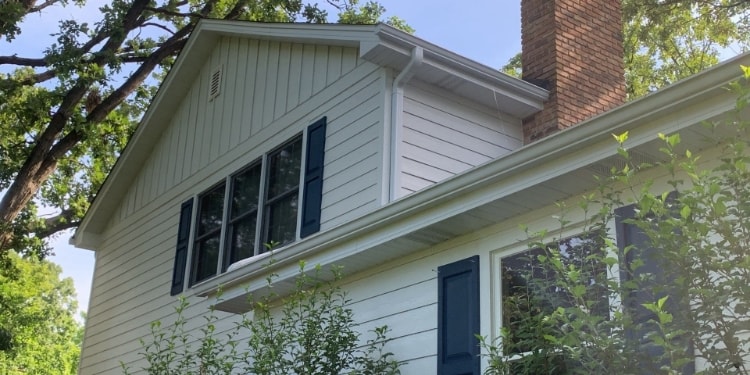
There are some rules to follow about colors, as well. For example, bright and bold colors on small home with little to no landscaping around can make it look like a doll house – it’s just what happens with these kinds of colors. Conversely, on a larger home in a wooded area, these same colors can look quite inviting and natural.
Another rule to follow is the color of your roof. If your roof has another two or three decades left in it, you’ll want to be sure the color you choose for your siding will not clash with your roof. So, if you have a dark roof, try lighter-colored siding. If your roof is a light color, go with darker colors in your siding.
Finally, you’re going to find there are a variety of colors to choose from that follow these basic rules, so your final “rule” is to match those colors to your personal preference.
Need help choosing siding colors? Contact our professional siding replacement contractor in DuPage County
DuPage County homeowners tackling a siding project know to inquire with the experts at VIS Exteriors when they have questions about choosing the right siding for their home, and the right color of siding and accent colors. Choosing the right color is important, as it can impact a home’s curb appeal and value, which is extremely important for anyone considering selling their home, but it’s also important for homeowners who have a vested interest in the appearance of their home.
VIS Exterior has become the go-to siding contractor in DuPage County for homeowners who know they need to work with someone they can trust. We bring years of experience to every job and consider each new project a custom assignment that we handle with the utmost care. From choosing the right type of siding to matching your color preferences with your style of home, we can provide you with the guidance you need to see a successful outcome. Contact us today and let’s talk about your siding project.
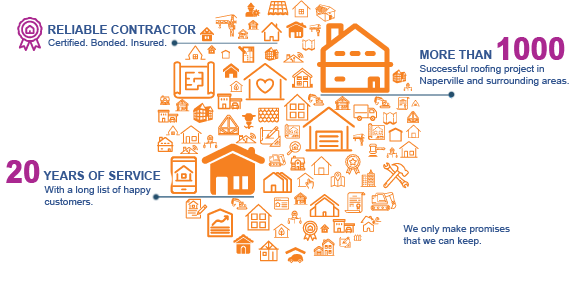
Expert answers to your frequently asked siding color questions
When you’re seeking out answers to your questions about siding color, go to the experts! Most homeowners will have similar questions as they try to narrow down which colors will look best on their home. At VIS Exterior, we’ve answered many, many questions and the following are some of the most common ones about choosing siding color.
Is light or dark siding better?
There is a right answer to this question, but it totally depends on your situation. Which shade doesn’t clash with the color of your roof? The general rule is that lighter roofs look better with darker siding and vice versa.
Is your house large or small? Light colors can make a small house look larger. At the same token, small houses really pop when you use darker siding, so if you don’t want to make a statement, just choose lighter siding.
Does your home get full sun during the daylight hours? Darker colors can generate more heat, particularly if your insulation isn’t great, so choose lighter colors. Furthermore, lighter colors won’t show fading as fast, either.
What is the most popular color for siding?
Gray and various shades of blue are currently the most popular siding colors. White and various shades of white have made a resurgence recently. What’s most important is that regardless of what’s trending, you should choose a color that fits your home and your neighborhood.
What siding color has the best resale value?
Homes with great curb appeal get more bids and sell faster. If your siding color is trending at the moment, it’s going to have more power on the housing market. However, if the trending color doesn’t look great on your home, you’re not going to see that advantage.
What the real estate market tells us is that overall, neutral colors tend to sell easier than bold colors. The math here is fairly simple – bold colors don’t attract as large an audience as neutral colors, simply because neutrals are more popular with a larger percentage of the population.
Again, while neutral colors might be the most popular, if your house doesn’t get a boost in curb appeal with it, choose a different color. The siding with the best resale value is the siding that looks best on your specific type of home.
What siding colors to avoid when selling your home?
Check out the following tips for making a good decision for your home:
- Talk to your realtor about what’s hot right now and if there are colors that are trending downward that you should avoid.
- Shy away from bright colors, as these only speak to a small percentage of home buyers.
- Don’t forget to match your siding with accent colors that are aesthetically pleasing.
What color siding shows less dirt?
If you’re looking for a rustic, really “lived in” look, white will show off dirt quite easily, which is why if you live in an area where debris and grime are an issue, you should stay away from white. Choosing off-white might be a better choice if you’re really set on a light color. You can also choose neutrals, such as sage, light blue and light gray, as these also show less grime.
What color of vinyl siding fades the least?
The darker the color, the more apt it is to show fading over time. That’s why if you live in an area that gets a lot of sun, you should choose a lighter color, as it will be far less likely to show its faded qualities. For example, a house with red siding will show far more fading that a house next door with beige siding.
What siding color makes a house look bigger?
As a general rule, light neutral colors will make a house appear larger than it actually is. Homeowners with smaller homes often follow this rule and find success. But it doesn’t have to be stark white. You can also choose light gray, sage green or ivory and still achieve a similar effect.
How to choose an exterior color combination?
The fun part of choosing siding colors is that you can achieve so many different effects simply by choosing different color combinations. Most designers will tell you that if you choose a darker color for your siding, you can create more contrast by choosing lighter colors for the trim, fascia and soffit.
By that token, the exact opposite would be true of siding that is light in color. Using a color swatch will help you get a better idea of exactly which accent colors work with your choice of siding color. You must also keep in mind that some styles of homes look awesome when the contrast between the two colors differs very little.
What siding color goes with a colored roof?
Consider these rules for the most common roof colors:
- Black roof:urrently, neutrals in white, beige and gray are trending for black roofs. Black goes with just about any color, so it is difficult to go wrong on this type of roof.
- Gray roof:rayish green siding looks great under a gray roof, but off-white is making a comeback. Various shades of blue also work.
- Brown roof:ook for warm stone colors and you will see some great matches.
- Green roof:et the classic look with stark white, or get into the warmer and inviting look with a variety of earth tones.
Should trim be lighter or darker than siding?
If you want your home to appear “framed in,” choose a trim color that is darker than your siding. You can choose a similar effect if your siding is darker than your trim colors. Also, the trim can help emphasize the color of your siding. For example, the gray siding looks fantastic with cream trim and many other light shades.
Should your windows match the siding?
You can always paint your window frames to add some personality to your home, but most are already a standard white color, which plays well with just about any siding/trim combination. Most designers agree that your windows do not need to be the same color as your siding.
What siding color goes with black windows?
Black, like white, pairs well with almost any color. You can put white trim around black windows and you will create the maximum amount of contrast. For less contrast, simply use a darker color of the trim.












